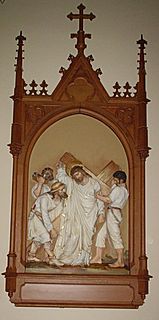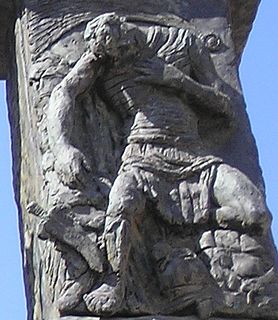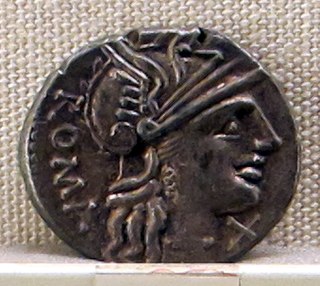Related Research Articles

Classical Latin is the form of Latin language recognized as a literary standard by writers of the late Roman Republic and early Roman Empire. It was used from 75 BC to the 3rd century AD, when it developed into Late Latin. In some later periods, it was regarded as good or proper Latin, with following versions viewed as debased, degenerate, or corrupted. The word Latin is now understood by default to mean "Classical Latin"; for example, modern Latin textbooks almost exclusively teach Classical Latin.
Gaius Musonius Rufus was a Roman Stoic philosopher of the 1st century AD. He taught philosophy in Rome during the reign of Nero and so was sent into exile in 65 AD, returning to Rome only under Galba. He was allowed to stay in Rome when Vespasian banished all other philosophers from the city in 71 AD although he was eventually banished anyway, returning only after Vespasian's death. A collection of extracts from his lectures still survives. He is also remembered for being the teacher of Epictetus and Dio Chrysostom.

Simon of Cyrene was the man compelled by the Romans to carry the cross of Jesus of Nazareth as Jesus was taken to his crucifixion, according to all three Synoptic Gospels:
And as they came out, they found a man of Cyrene, Simon by name: him they compelled to bear his cross.

Rufus Arthur Johnson, better known by his stage name Bizarre, is an American rapper, best known for his work with the Detroit-based hip hop group D12.

Quintus Curtius Rufus was a Roman historian, probably of the 1st century, author of his only known and only surviving work, Historiae Alexandri Magni, "Histories of Alexander the Great", or more fully Historiarum Alexandri Magni Macedonis Libri Qui Supersunt, "All the Books That Survive of the Histories of Alexander the Great of Macedon." Much of it is missing. Apart from his name on the manuscripts, nothing else certain is known of him. This fact alone has led philologists to believe that he had another historical identity, to which, due to the accidents of time, the link has been broken. A few theories exist. They are treated with varying degrees of credibility by various authors. Meanwhile, the identity of Quintus Curtius Rufus, historian, is maintained separately.

Fort Greene Park is a city-owned and -operated park in Fort Greene, Brooklyn, New York City. The 30.2-acre (12.2 ha) park was originally named after the fort formerly located there, Fort Putnam, which itself was named for Rufus Putnam, George Washington's Chief of Engineers in the Revolutionary War. Renamed in 1812 for Nathanael Greene, a hero of the American Revolutionary War, it was redesigned by Frederick Law Olmsted and Calvert Vaux, who also designed Central Park and Prospect Park, in 1867. The park contains the Prison Ship Martyrs' Monument, which includes a crypt designed by Olmsted and Vaux.

Rufus McGarrigle Wainwright is an American-Canadian singer, songwriter, and composer. He has recorded 10 studio albums and numerous tracks on compilations and film soundtracks. He has also written two classical operas and set Shakespeare's sonnets to music for a theater piece by Robert Wilson.

The Bar Kokhba revolt, or the 'Jewish Expedition' as the Romans named it, was a rebellion by the Jews of the Roman province of Judea, led by Simon bar Kokhba, against the Roman Empire. Fought circa 132–136 CE, it was the last of three major Jewish–Roman wars, so it is also known as the Third Jewish–Roman War or, the Third Jewish Revolt. Some historians also refer to it as the Second Revolt of Judea, not counting the Kitos War, which had only marginally been fought in Judea.

Rufus Frederik Sewell is a British film and stage actor. In film, he has appeared in Carrington (1995), Hamlet (1996), Dangerous Beauty (1998), Dark City (1998), A Knight's Tale (2001), The Legend of Zorro (2005),The Illusionist (2006), Amazing Grace (2006), The Holiday (2006), Paris, je t'aime (2006), Judy (2019), The Father (2020), and Old (2021).
Rufus is a masculine given name, a surname, an Ancient Roman cognomen and a nickname. Notable people with the name include:

Taxiles was the Greek chroniclers' name for the ruler who reigned over the tract between the Indus and the Jhelum (Hydaspes) Rivers in the Punjab region at the time of Alexander the Great's expedition. His real name was Ambhi, and the Greeks appear to have called him Taxiles or Taxilas, after the name of his capital city of Taxila, near the modern city of Attock, Pakistan.

The gens Minucia was an ancient Roman family, which flourished from the earliest days of the Republic until imperial times. The gens was apparently of patrician origin, but was better known by its plebeian branches. The first of the Minucii to hold the consulship was Marcus Minucius Augurinus, elected consul in 497 BC.

Rufus is a fictional character in the Street Fighter series of fighting games. Designed by Daigo Ikeno for Capcom's development team, he first appeared in the arcade version of Street Fighter IV and later in related promotions and media for the title.
Quintus Tineius Rufus, also known as Turnus Rufus the Evil in Jewish sources was a senator and provincial governor under the Roman Empire. He is known for his role unsuccessfully combating the early uprising phase of the Jews under Simon bar Kokhba and Elasar.
Orxines was a Persian noble, descended from Cyrus the Great.
References
- ↑ Pliny the Elder, The Natural History CHAP. 81. (20.)—REMARKABLE FACTS RELATIVE TO ANIMALS - John Bostock, M.D., F.R.S., H.T. Riley, Esq., B.A., Ed. Plin. Nat. 28.81 (footnote 17). Perseus Project [Retrieved 2015-04-12]
- 1 2 3 W. Ramsey - Professor of Humanity University of Glasgow (1873). A Dictionary of Greek and Roman Biography and Mythology, Volume 3. J. Murray, 1873. Retrieved 2015-04-12.